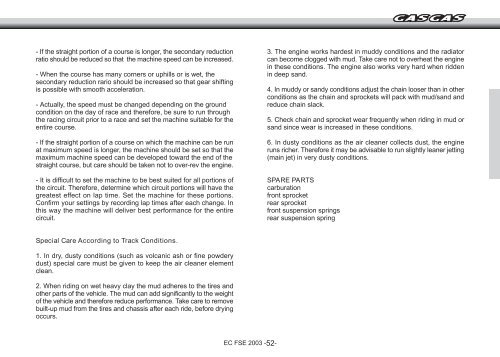You also want an ePaper? Increase the reach of your titles
YUMPU automatically turns print PDFs into web optimized ePapers that Google loves.
- If the straight portion of a course is longer, the secondary reduction<br />
ratio should be reduced so that the machine speed can be increased.<br />
- When the course has many corners or uphills or is wet, the<br />
secondary reduction rario should be increased so that gear shifting<br />
is possible with smooth acceleration.<br />
- Actually, the speed must be changed depending on the ground<br />
condition on the day of race and therefore, be sure to run through<br />
the racing circuit prior to a race and set the machine suitable for the<br />
entire course.<br />
- If the straight portion of a course on which the machine can be run<br />
at maximum speed is longer, the machine should be set so that the<br />
maximum machine speed can be developed toward the end of the<br />
straight course, but care should be taken not to over-rev the engine.<br />
- It is difficult to set the machine to be best suited for all portions of<br />
the circuit. Therefore, determine which circuit portions will have the<br />
greatest effect on lap time. Set the machine for these portions.<br />
Confirm your settings by recording lap times after each change. In<br />
this way the machine will deliver best performance for the entire<br />
circuit.<br />
Special Care According to Track Conditions.<br />
1. In dry, dusty conditions (such as volcanic ash or fine powdery<br />
dust) special care must be given to keep the air cleaner element<br />
clean.<br />
2. When riding on wet heavy clay the mud adheres to the tires and<br />
other parts of the vehicle. The mud can add significantly to the weight<br />
of the vehicle and therefore reduce performance. Take care to remove<br />
built-up mud from the tires and chassis after each ride, before drying<br />
occurs.<br />
EC FSE 2003 -52-<br />
3. The engine works hardest in muddy conditions and the radiator<br />
can become clogged with mud. Take care not to overheat the engine<br />
in these conditions. The engine also works very hard when ridden<br />
in deep sand.<br />
4. In muddy or sandy conditions adjust the chain looser than in other<br />
conditions as the chain and sprockets will pack with mud/sand and<br />
reduce chain slack.<br />
5. Check chain and sprocket wear frequently when riding in mud or<br />
sand since wear is increased in these conditions.<br />
6. In dusty conditions as the air cleaner collects dust, the engine<br />
runs richer. Therefore it may be advisable to run slightly leaner jetting<br />
(main jet) in very dusty conditions.<br />
SPARE PARTS<br />
carburation<br />
front sprocket<br />
rear sprocket<br />
front suspension springs<br />
rear suspension spring



